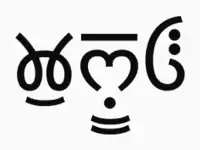Kullui
Kului (Kullū, also known as Kulvi, Takri: 𑚊𑚰𑚥𑚷𑚱𑚃/𑚊𑚰𑚥𑚷𑚱𑚦𑚯) is a Western Pahari language spoken in Himachal Pradesh.
| Kullui | |
|---|---|
| 𑚊𑚰𑚥𑚷𑚱𑚃, कुळूई, kuḷūī | |
 kuḷūī written in Takri Script | |
| Native to | India |
| Region | Himachal Pradesh |
Native speakers | 196,295 (2011)[1] Census results conflate some speakers with Hindi. |
| Takri, Devanagari | |
| Language codes | |
| ISO 639-3 | kfx |
| Glottolog | kull1236 |
Phonology
Consonants
| Bilabial | Dental | Alveolar | Retroflex | Palatal | Velar | Pharyngeal | Glottal | |||||||
|---|---|---|---|---|---|---|---|---|---|---|---|---|---|---|
| Plosive | p pʰ |
b bʱ |
t̪ t̪ʰ |
d̪ d̪ʱ |
ʈ ʈʰ |
ɖ ɖʱ |
k kʰ |
ɡ ɡʱ |
ʔ | |||||
| Affricate | ts tsʰ |
dz dzʱ |
c͡ç c͡çʰ |
ɟ͡ʝ ɟ͡ʝʱ |
||||||||||
| Fricative | s | ɕ | ħ | ɦ | ||||||||||
| Nasal | m | n̪ | ɳ | ɲ | ŋ | |||||||||
| Trill/Flap | r | ɽ | ||||||||||||
| Lateral | l | ɭ | ||||||||||||
| Approximant | j | |||||||||||||
For the stops and affricates there is a four-way distinction in phonation between tenuis /p/, voiced /b/, aspirated /pʰ/ and breathy voiced /bʱ/ series. Thakur (1975, pp. 175–8) lists as separate phonemes aspirated correlates of /ŋ/, /n/, /m/, /j/, /r/, /ɽ/, /l/ and /ɭ/, but describes the aspiration as a voiceless pharyngeal friction. /n̪/ is dental, but becomes alveolar if the next syllable contains a retroflex consonant. /ŋ/ and /ɲ/ are rare, but contrast with the other nasals word-medially between vowels. /ɳ/, /ɭ/ and /ɽ/, together with their aspirated correlates, don't occur in the beginning of words.[2] The glottal stop occurs only between a vowel and /ɳ/, /n/, /r/ or /l/, e.g. [kɑːʔɭ] "a trumpet", which contrasts with [kɑːɭ] "famine". The pharyngeal fricative /ħ/ historically derives from /s/ and occurs word-finally, e.g. [ɡʱɑːħ] "grass", [biːħ] "twenty".[3]
Status
The language is commonly called Pahari or Himachali. Some speaker may even call it a dialect of Punjabi or Dogri. The language has no official status. According to the United Nations Education, Scientific and Cultural Organisation (UNESCO), the language is of definitely endangered category, i.e. many Kulluvi children are not learning Kulluvi as their mother tongue any longer.[4]
The demand for the inclusion of 'Pahari (Himachali)' under the Eight Schedule of the Constitution, which is supposed to represent multiple Pahari languages of Himachal Pradesh, had been made in the year 2010 by the state's Vidhan Sabha.[5] There has been no positive progress on this matter since then even when small organisations are taking upto themselves to save the language and demanding it.[6] Due to political interest, the language is currently recorded as a dialect of Hindi,[7] even when having a poor mutual intelligibility with it.
Notes
- "Statement 1: Abstract of speakers' strength of languages and mother tongues - 2011". www.censusindia.gov.in. Office of the Registrar General & Census Commissioner, India. Retrieved 2018-07-07.
- Thakur 1975, p. 180. An exception is the word [ɽəbɑːɳɑː] "to throw".
- Thakur 1975, p. 181.
- "Endangered languages".
- "Pahari Inclusion". Zee News.
- "Pahari Inclusion". The Statesman.
- "Indian Language Census" (PDF).
Bibliography
- Thakur, Mauluram (1975), Pahāṛī bhāṣā, Delhi: Sanmarg Prakashan
External links
- Pahari-languages.ru, a Kullui documentation project
